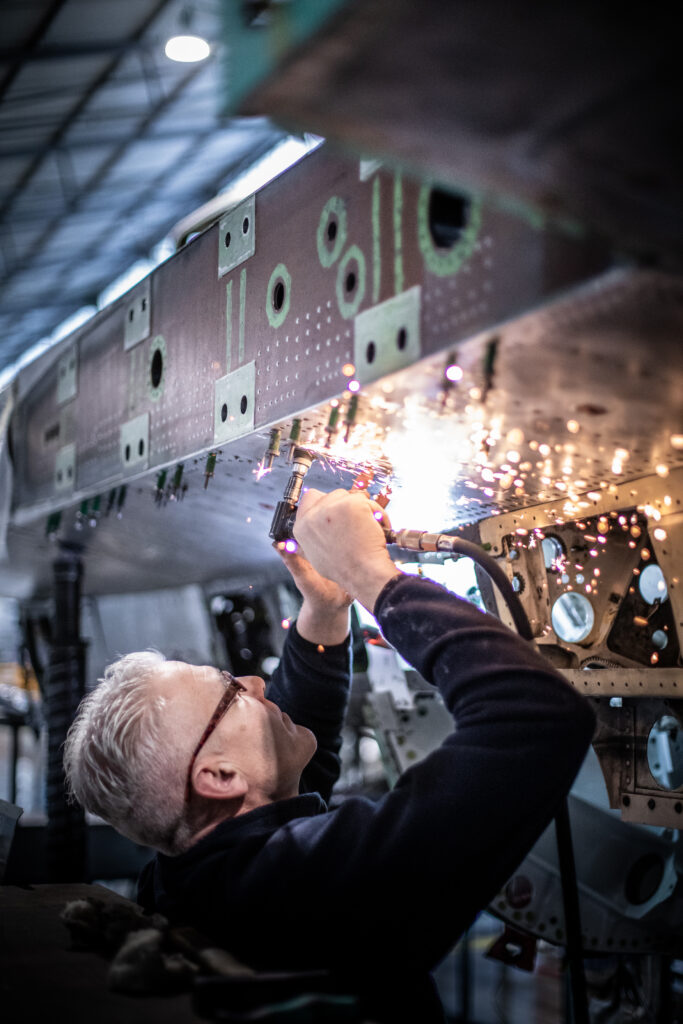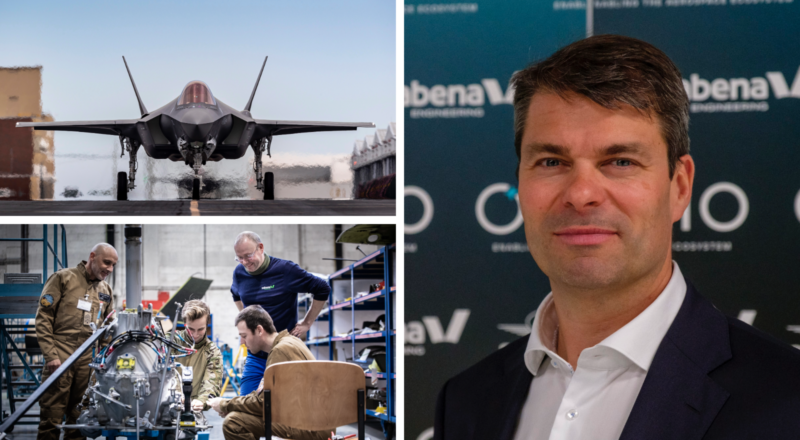We met Stéphane Burton, CEO of the Orizio Group, at the SABCA site, a stone’s throw from Brussels Airport. The room is decorated with models of civil and military aircraft and rockets, testimony of Belgium’s contribution to aerospace developments over the past decades.
In between meetings, Orizio’s CEO warmly welcomed us for an informal discussion on the Belgian aerospace business and the future of the Orizio Group.

As a reminder, Orizio is active in civil and military aircraft structures and equipments, space launchers (structures and actuators) and civil and military aircraft maintenance. Coming soon: aircraft recycling…
How do you assess the integration of Sabca and Sabena Engineering? How is Orizio positioned today? And how do you see the future of the group?
We completed the acquisition of SABCA in 2020; it proved to be a rather sensitive time, given the emergence of the Covid crisis and the difficulties associated with the decline in production volumes by the major aircraft manufacturers. Today, demand is there, but supply is not yet in a position to keep pace, as the supply chain has not yet fully recovered. On the other hand, the context of the pandemic was transformed into a real opportunity for Sabena Engineering and the Orizio Group’s MRO activities. During the covid crisis, the cargo business was operating at full capacity and the slowdown in activity was used as a valuable opportunity to swiftly complete the integration of Orizio Group’s MRO division, bringing together ex-Sabena Aerospace and ex-Sabca MRO, as well as ex-Lufthansa Technik Brussels!
Today, the MRO business – which has reached maturity – will post sales 50% higher than in 2019.
Looking ahead to 2024 -barring a new crisis- we are anticipating a promising year for Sabena Engineering. We have renewed long-term contracts in our defense and commercial aviation divisions, and we have developed new products, particularly following the acquisition of Lufthansa Technik Brussels, which has an engine business and a dedicated service for aircraft leasing companies. We also acquired a 70% stake in Aircamo, a UK company specializing in airworthiness management and engine support for aircraft leasing companies.

Simultaneously, at Sabca, we will start delivering new composite aerostructure products and finalizing production of the new electro-mechanical actuation equipment.
In summary, the Orizio Group remains in a phase of general growth, and this applies to both of its subsidiaries. The outlook for the future is encouraging, as we see the end of the effects of the Covid crisis and we continue to diversify both our products and customer portfolios.
What is the status of the project to establish an aircraft dismantling facility in Belgium? What would be Orizio’s added value and what would be the ROI of such an activity for Belgium? What is the future for recycled materials?
For Orizio, this project is all about recycling materials from the aviation industry. The commercial aircraft fleet is estimated at around 35,000 and could reach 46,500 by 2040. More than half of the current fleet will be retired in the next 5 to 7 years. Up until now, the cost of aircraft dismantling and material recycling has been so high that many operators decide to store them in the desert in the US or elsewhere… As for Europe, we believe that it is essential to promote recycling rather than the extraction of new materials.
In partnership with the Comet Group, we have launched a preliminary study that has enabled us to develop an economic model. We have also decided to work with a research center to study the recycling of composite materials. Once the materials are extracted, Comet will resell them to industry. This is a joint initiative.
For Orizio, the benefits of such a project are twofold: first, it means contributing to the recycling business as such. Secondly, it means learning more about the specific characteristics of recyclable materials so that we can incorporate them into new developments and design components that are easier and easier to recycle. It’s all part of our capability and responsibility! It’s a way of contributing to the decarbonization of the sector. Finally, it will also allow us to improve and optimize our maintenance processes.
Belgium is a small country at the forefront of aerospace research and design. What do you think is Belgium’s added value in today’s global aerospace and defense market? What’s special about Belgium?
What characterizes Belgium is both modesty and competence. Belgian aerospace and defense companies have developed a niche strategy. In these niches, they strive to be global leaders, even if they are modest about it (he smiles): propulsion, aerostructures and wings of the future are just a few examples of areas where Belgium stands out and excels. At the same time, we benefit from the expertise of leading research centers and universities in space technologies and the development of disruptive technologies, enabling Belgium to play an active role in the decarbonization of the aviation sector.
Finally, I would like to highlight the strengthening of the industrial policy developed over the last 3 years. DIRS promotes the development and sustainability of a high-performance defense industrial and technological base and positions Belgium as a relevant, reliable and competitive technological partner.
As 2023 draws to a close, what are the highlights of 2024 for the Orizio Group?
March 28, 2024 will be one of the highlights of the year as we celebrate the century of aviation in Belgium! For Orizio, this celebration will also be an opportunity to attract young people back to the aeronautical industry, a sector that combines passion with a meaningful profession and offers real opportunities to acquire technical knowledge in an environment where the notion of camaraderie still prevails…

2024 will also see the delivery of the first Horizontal Tail Planes for the F-35.
A second project for which SABCA has been selected by Lockheed Martin concerns the F-35 lower wing skins of the fifth-generation fighter. Based on an innovative Automated Fiber Placement (AFP) composite manufacturing technology, this capability could subsequently be applied to other Wings of the Future programs, both military and commercial. To be continued…
Image F-35 ©️ Lockheed Martin
Images ©️Orizio

